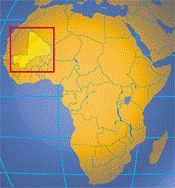International Sorghum and Millet Collaborative Research Support Program (INTSORMIL CRSP)
Date of this Version
10-5-2010
Document Type
Article
Citation
USAID SUCCESS STORY (October 5, 2010)
Abstract
Mr. Seydou Kone, a 44 year-old sorghum farmer from the village of Garasso in Sikasso region is a hard worker and dedicated farmer. However, in his field, yields of the local sorghum variety have never exceeded 1.2 metric tons per hectare. In 2008, when he heard about the increased productivity made possible by the adoption of a new sorghum hybrid variety “Grinkan”, he saw, as many other producers in Garasso, a great opportunity to improve his sorghum productivity.
Through the technical assistance provided by the NGO AMEDD, Mr Seydou Kone remarkably improved his technical skills regarding sorghum production. First and foremost, land preparation is an essential first step in his crop management. He uses water harvesting techniques to increase the soil moisture and improve the response of the sorghum cultivar to the use of inorganic fertilizer. Organic fertilizer is used during land preparation and the seeds are sowed on ridges. The use of inorganic fertilizer in the form of Di-Ammonium Phosphate and urea provides all the nutrients necessary for the plant growth. A big technical innovation is the implementation of plant thinning. Every year, this agronomic practice is performed on the basis of two plants per hole as suggested.
The rigorous application of these agricultural practices has helped Mr. Kone to make impressive yield gains. Indeed, in 2009, he was the best sorghum farmer in the village and achieved a yield of 3 metric tons per hectare, almost three times what he was able to harvest under the traditional technology. Mr Kone is a model of work achievement in the village and an inspiring example for other producers willing to adopt the new sorghum technology. With the adoption of the sorghum technical innovations, his family’s household grain consumption has improved, and as it has never happened in the past, sorghum is now used as a source of cash income. The profit resulting from the sales of sorghum is evaluated at $708 per hectare. This income has helped Mr Kone to meet the necessary household expenditures and improve his family’s living standard through the purchase of a new means of transportation and some housing improvements.


